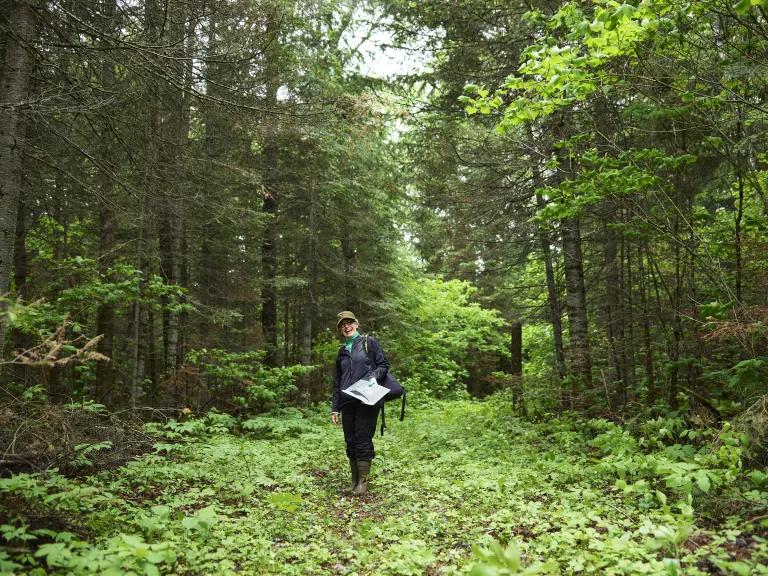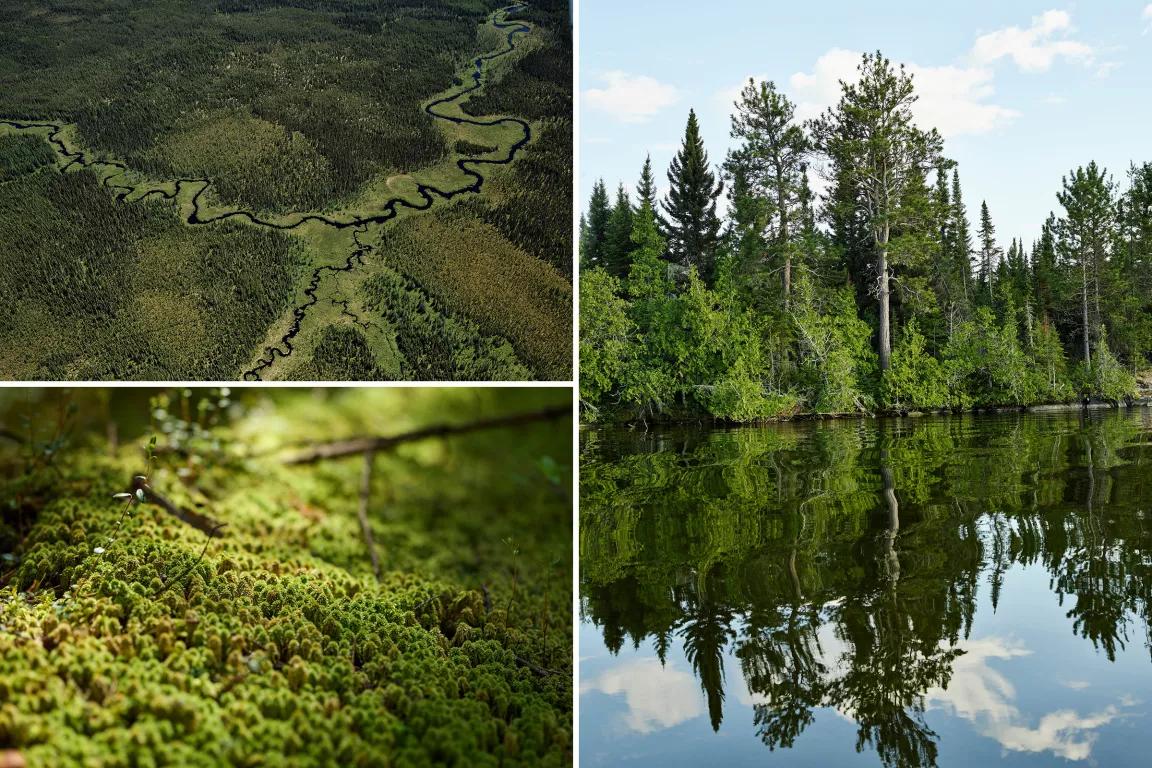A Tale of Two Forests: A Tour Through Canada’s Boreal
One of the most majestic old-growth forests on earth, Canada’s boreal is becoming a wasteland due to rampant logging.

River Jordan for NRDC
At more than one billion acres, Canada’s boreal forest—a magnificent crown of trees that caps North America—is one of the world’s largest natural carbon storehouses and plays a key role in regulating our climate.
While many areas remain undisturbed, industrial development—primarily logging, but also mining and tar sands oil production—has imposed an ever-increasing footprint on the largest remaining intact forest in the world. These photos, taken on a recent trip to the boreal by NRDC staff, show what’s at stake if industry continues to run rampant in one of our world’s most spectacular wild places.
The Majestic Wood
More than 600 Indigenous communities, like the Cree First Nation of Waswanipi and the Atikamekw First Nation, call the forest home. “These communities are inextricably tied to the land to sustain ancient and sacred ways of life,” says Jennifer Skene, an NRDC environmental law fellow who works to safeguard the boreal.
Iconic wildlife species like the bald eagle, snapping turtle, and beaver also live here, among the birch and black spruce and balsam fir, and billions of migratory birds nest in the forest’s abundant wetlands and along its free-flowing waterways. Threatened species like the boreal caribou and pine marten depend on the forest for their last remaining habitat, too.
Due to Canada’s colder temperatures, the boreal is slow-growing, and its dead vegetation and leaves are slow to decompose. When trees, moss, and lichens die and fall to the ground or into the region’s shallow bogs, they don’t break down readily. Instead they build thick layers of organic material called peat. All that organic material serves a particularly important function: It stores carbon—a whole lot of it. The Canadian boreal keeps more carbon in its soil, peatlands, trees, and permafrost than all the carbon in active oil, gas, and coal reserves around the world.
A Landscape Under Siege
Once an unbroken expanse of deep green, the boreal landscape viewed from above now reveals permeating cookie-cutter damage, with snaking roads, splotches of brown, and barren soil. Each year, loggers clearcut a million acres of boreal forest, felling giant trees and leaving bare land and gnarled stumps in their wake. The vast majority of boreal wood goes to the United States, where it ends up in many products, including single-use, throwaway paper products like toilet paper. In the span of just two decades, the logging industry has stripped away an area roughly the size of Ohio. The breakneck pace shows no signs of slowing.

River Jordan for NRDC
The logging industry views forests like the boreal as a renewable resource. “One of the most pernicious myths of the Canadian logging industry,” Skene says, “is that when they cut the forest down, it grows back exactly as it was, so they aren’t really causing long-term damage. Unfortunately, that’s simply not true.”
In reality, what’s replanted might as well be another forest entirely. Diverse ecosystems, fine-tuned over centuries, are replaced by a homogenous grid of trees. On the ground, the divisions are clear—lush, mossy overgrowth on one side;spindly, man-made rows resembling a Christmas tree farm on the other. Even cultivated forest that’s been regrowing for a half century looks starkly different from the undisturbed, natural version.

River Jordan for NRDC
As trucks trample the soil and the trees are felled, the delicate balance of biodiversity is forever altered at every level of the food chain. Boreal caribou are disappearing, which is particularly devastating for many Indigeneous people, who use caribou as a source of food and clothing and in cultural traditions like coming-of-age hunts. Valérie Courtois, an Innu forester, has even said, “Without the caribou, we will no longer be Innu.” But the caribou have never been seen returning to replanted boreal, Skene notes, likely because the loss of vegetation reduces both their food supply and secure coverage from predators. “When the logging industry enters an area in the boreal, the forests are managed for their own benefit, not the benefit of the ecosystem,” she says. The profits of this forest destruction are shared across the supply chain, from the mills that process the wood pulp to the companies—often based in the United States—that sell the manufactured goods.
Along with damaging ecosystems, clearcutting releases vast amounts of the carbon that is stored in the trees and in the disturbed soil. It’s not until decades later that replanted trees return to serving as carbon sinks—far too long when we’re facing a climate emergency that requires immediate reductions of carbon.. By the time these new trees start sequestering carbon, we will have careened past our 1.5-degree threshold to avoid climate catastrophe.

River Jordan for NRDC
Saving the Boreal
Canada’s leaders must take action to address this growing crisis. For starters, we need a policy overhaul. It will require transparency and ownership of logging’s consequences from both industry and government leaders. New policies must also account for the true costs of boreal clearcutting. Currently Canada does not include emissions from forestry in its national greenhouse gas inventory, which the country provides to the United Nations to track progress toward its emissions targets. For example, Ontario’s logging industry clearcuts an average of 318,000 acres a year, which releases 8.3 million metric tons of carbon dioxide into the atmosphere. This is the equivalent of 31 percent of the emissions Canada has committed to cut by 2020—yet it’s nowhere in its calculations.
The Canadian government also needs to work alongside Indigenous peoples to develop stricter land and wildlife protections that stem the tide of logging and respect the sovereignty of First Nations. “In many cases you see territories being degraded without approval from the Indigenous community,” Skene says, “and the industrial activity then doesn’t always bring them much of the economic benefit.”

River Jordan for NRDC
Industry, too, must own up to its role in the crisis. This includes corporations that regularly manufacture their products using virgin boreal wood. Companies like Procter & Gamble, which owns the toilet paper brand Charmin, should shift to using recycled paper, which has a fraction of the carbon footprint of virgin wood, as well as environmentally preferred alternative fibers, which drastically reduce the impact toilet paper has on our forests globally. Currently, Charmin uses no recycled paper or alternative fibers at all. This tree-to-toilet pipeline must stop.
Local advocacy groups, like the Farabout Peninsula Coalition, are calling for change on the ground. The coalition—which includes the Eagle Lake First Nation, permanent and seasonal residents, and local businesses—works to prevent clearcutting in a thumbprint of intact Ontario boreal forest that’s connected to the mainland via a narrow strip of land. The region—home to a robust fishing industry, rare plant species, and thousands of Indigenous artifacts—would be easily exploited were it not for their loud voices of opposition.

River Jordan for NRDC
Dale Mackenzie (above), who grew up in a fishing lodge near Eagle Lake, where she continues to spend most of her summers, is chair of the coalition. With the blessing of Eagle Lake First Nation, she’s helped organize archaeological digs that have turned up thousands of artifacts, like pottery and arrowheads. The discoveries prevented (for now, at least) the building of a road across the isthmus that would have enabled industry to carry logs out of the peninsula. “Our strategy was to see if we could find something significant, and if so, register it,” Mackenzie says. “Because how could you build a road on top of it? It’s like putting a road through a cemetery or a museum.”
Of course, individuals can do their part, too. Buy from brands that source their paper sustainably, and call on the companies fueling the tree-to-toilet pipeline to prioritize conservation, respect the rights of Indigenous peoples, and stop sourcing from one of the last and largest remaining intact forests in the world. Because once the boreal’s gone, it’s gone for good.
This NRDC.org story is available for online republication by news media outlets or nonprofits under these conditions: The writer(s) must be credited with a byline; you must note prominently that the story was originally published by NRDC.org and link to the original; the story cannot be edited (beyond simple things such as grammar); you can’t resell the story in any form or grant republishing rights to other outlets; you can’t republish our material wholesale or automatically—you need to select stories individually; you can’t republish the photos or graphics on our site without specific permission; you should drop us a note to let us know when you’ve used one of our stories.






Mapping a Future for Boreal Caribou
Keeping the Spirit Bear Coast Clear of Tar Sands Oil
The Best and Worst Toilet Paper, Paper Towel, and Facial Tissue Brands